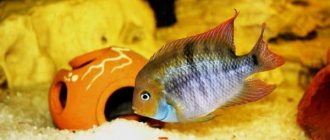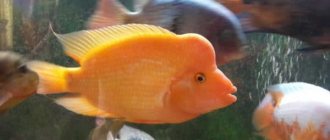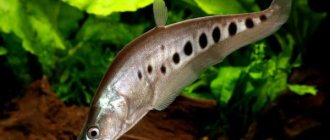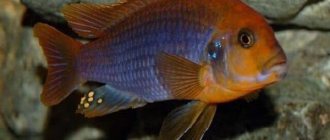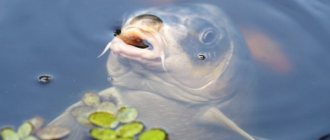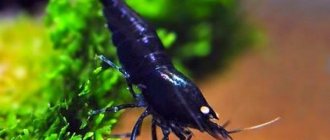Cichlasoma salvini (lat. Cichlasoma salvini), when purchased as a teenager, is a rather gray fish that attracts little attention. But everything changes when it becomes an adult, then it is a very beautiful and bright fish, which is noticeable in the aquarium and the eye stops on it. Salvini is a medium-sized fish, it can grow up to 22 cm, but is usually smaller. Just like all cichlids, it can be quite aggressive, as it is territorial. They are a predator and will eat small fish, so they need to be kept either separately or with other cichlids.
Habitat in nature
Cichlazoma salvini was first described by Gunther in 1862. They live in Central America, southern Mexico, Honduras, and Guatemala. They were also brought to the states of Texas and Florida.
Salvini cichlizomas live in rivers with medium and strong currents, feeding on insects, invertebrates and fish.
Unlike other cichlids, salvini spend most of their time hunting in the open spaces of rivers and tributaries, and not along the banks among stones and snags, like other species.
Maingano Cichlid photo
Maingano is a medium-sized dark blue cichlid measuring 7-10 cm. It has an elongated body, a rounded nose and golden eyes. There is a long fin on the back with two blue lines. There are also two light blue horizontal stripes running along the body, one thin line edging the fins and tail. To cut tough algae from stones, the cichlid uses its incisors.
The habitat of these Cichlids is Lake Malawi, whose water is highly mineralized and alkaline, specifically the rocky coastline of the large island of Likom. They prefer to be at depths of three to ten meters. They feed on algae, snails and small crustaceans, invertebrates, insect larvae, and zooplankton.
Description
The body is elongated, oval in shape with a sharp muzzle. In nature, salvini grow up to 22 cm, which is slightly larger than the average size of Central American cichlids.
In an aquarium they are smaller, about 15-18 cm. With good care, they can live up to 10-13 years.
In young and immature fish, the body color is grayish-yellow, but over time it turns into a magnificent coloration. The adult Salvini cichlid is yellow in color, but there are black stripes along the yellow background.
One, continuous, runs along the central line of the body, and the second breaks up into separate spots and passes over the first. The abdomen is red.
Characteristics of individual representatives
Among the zebra-like elongatus, you immediately notice Pseudotropheus elongatus chevere. Their narrow and long body is well suited for caves and tight crevices.
In nature, they implement their habits through cave excursions. Moreover, inside the cave they are often located belly up.
Large owners of the territory. Where chevers live, it is unlikely that it will be possible to distinguish another species.
They like to scrape off rocky growths with their specialized teeth, raking up algae and other loose material.
Pseudotropheus elongatus mpanga has 5 to 12 black stripes on a violet-blue background. This elongatus in nature lives at a depth of 4-20 m, preferring an area without sediment. Perhaps this is the only species that can be conditionally classified as trouble-free and easy to maintain. However, it requires:
- large aquarium;
- specific rock scenery;
- a suitable group of “neighbors”.
The description of the composition of the water should be as close as possible to the places where Malawian cichlids live (water 22-32 o C, hardness from 3 to 19, acidity from 7.3 to 8.4).
A very beautiful and interesting fish is Pseudotropheus elongatus chailosi (many photos are available on the Internet). The brightness of its color can outshine all other inhabitants. When chosen correctly, its body shimmers with gold. A stripe of the same shade runs along the outer edge of the dorsal fin, creating a kind of areola around the body.
Feeding
Although Cichlasoma salvini is considered an omnivorous fish, in nature it is still more of a predator that feeds on small fish and invertebrates. In the aquarium they eat all types of live, frozen or artificial food.
The basis of feeding may well be special food for cichlids, and in addition you need to give live food - brine shrimp, tubifex, and bloodworms in small quantities.
They also enjoy eating chopped vegetables, such as cucumber or spinach.
Feeding teenagers:
Cichlazoma Salvini
Cichlazoma salvini
Habitat: eastern Central America. Water parameters for keeping: 22-28°C, dH 4-25°, pH 6.9-8.5. The body of Cichlazoma salvini is dark green or yellow-brown. From the snout through the eye up to the dark spot in the upper part of the base of the caudal fin there is a vaguely limited strip, which arcs around the dark spot located in the middle of the body. The dorsal fin is green-blue with a red border, the elongated end is clay-yellow. The caudal fin and anal fin are clay-yellow at the base and red on the outside.
The male is more intensely colored, the fins are more elongated. The female has a black spot on the middle of the dorsal fin and the lower part of the operculum. The length of the male is up to 16 cm, the female is up to 13 cm.
Keeping in an aquarium
For a couple of fish you need an aquarium with a volume of at least 200 liters; naturally, the larger it is, the larger your fish will grow. If you plan to keep them with other cichlids, then the volume should be from 400 liters.
Although the fish is not particularly large (about 15 cm), it is very territorial and fights will inevitably arise with other cichlids.
To keep Salvini, you need an aquarium that has both shelter and enough free space for swimming. Pots, driftwood, stones or caves are suitable as shelters.
Salvini cichlazomas do not damage plants or undermine them, but they look much better against the background of greenery. So the aquarium can be laid out with dense thickets and shelters along the walls and in the corners, and an area open for swimming in the middle.
As for the water parameters, it should be clean and low in nitrates and ammonia. This means weekly water changes (up to 20%) and it is advisable to use an external filter.
In addition, they love current, and creating it using an external filter is not a problem. In this case, water parameters: temperature 23-26 ° C, pH: 6.5-8.0, 8 - 15 dGH.
Characteristics of individual representatives
Among the zebra-like elongatus, you immediately notice Pseudotropheus elongatus chevere. Their narrow and long body is well suited for caves and tight crevices.
In nature, they implement their habits through cave excursions. Moreover, inside the cave they are often located belly up.
Large owners of the territory. Where chevers live, it is unlikely that it will be possible to distinguish another species.
They like to scrape off rocky growths with their specialized teeth, raking up algae and other loose material.
Pseudotropheus elongatus mpanga has 5 to 12 black stripes on a violet-blue background. This elongatus in nature lives at a depth of 4-20 m, preferring an area without sediment. Perhaps this is the only species that can be conditionally classified as trouble-free and easy to maintain. However, it requires:
- large aquarium;
- specific rock scenery;
- a suitable group of “neighbors”.
The description of the composition of the water should be as close as possible to the places where Malawian cichlids live (water 22-32 o C, hardness from 3 to 19, acidity from 7.3 to 8.4).
A very beautiful and interesting fish is Pseudotropheus elongatus chailosi (many photos are available on the Internet). The brightness of its color can outshine all other inhabitants. When chosen correctly, its body shimmers with gold. A stripe of the same shade runs along the outer edge of the dorsal fin, creating a kind of areola around the body.
Compatibility
Definitely not suitable for a community aquarium with small fish such as neon or guppies. These are predators that perceive small fish only as food.
They also protect their territory and can drive other fish away from it. It is best kept with catfish such as tarakatum or sacbranchs. But it is also possible with other cichlids - black-striped, Managuan, meeca.
Please note that the larger the cichlids, the more spacious the aquarium should be, especially if one of them begins to spawn.
Of course, it is ideal to keep them separately, but if this is not possible, then abundant feeding and plenty of shelters help reduce aggression.
Attractiveness and aggressiveness
The eight-banded cichlazoma has a low and compact body. It can grow up to 25 cm in length. Growing up, she becomes unusually beautiful, but for this she needs at least a year. Like many other fish, for example the Congo tetra, the male is especially bright and beautiful.
The male is given a special brightness by a large number of diamond dots scattered throughout the body and a red edging along the edge of two unpaired fins: anal and dorsal.
When falling into a state of stress, the eight-banded cichlazoma bee may become darker. In a calm state, its color is light blue. As the name suggests, there are eight dark stripes across her body, which are especially noticeable from the back area. One dark spot can be seen at the base of the caudal fin and in the center of each side.
Character and behavioral characteristics
The English name of this beautiful fish is the cichlid Jack Dempsey, named after the American boxer Jack Dempsey, given due to its cocky character and ability to sort things out for hours and selflessly defend its territory. Bees demonstrate the greatest aggression during the breeding and spawning periods.
Selective cichlazomas of bees
Thanks to crossbreeding, there are many different color options without clear stripes on the sides and brighter blues, and the nature of the artificially produced variations is more peaceful. And today aquarists are more attracted not by the aggressive nature of the cichlid bee itself, but by the rich color of its selection forms.
But the subtleties of breeding are still an obstacle to its widespread distribution, so it is rare. A photo of Blue Dempsey bee cichlasoma shows a surprisingly bright turquoise color with a black pattern.
Blue Dempsey differs from the original form of cichlid by its calm disposition, even some shyness. But, if they are kept in pairs, then aggressiveness and territoriality begin to appear. It has also been noted that their aggressiveness increases with age. Therefore, to suppress aggression, some aquarists keep them at a lower temperature. The video demonstrates how beautiful the blue Dempsey cichlid is.
Breeding eight-banded cichlazoma
Cichlazoma eight-striped is bred and kept quite simply. Sex differences in adults are determined based on the size and shape of the dorsal and anal fins:
- The male has a more massive body and elongated ends of unpaired fins; sometimes there may be a slightly convex forehead.
- The smaller female is darker in color, this is especially evident during spawning, when only the upper part of the head and body remains light, and the entire body is almost black.
During reproduction, the female has an ovipositor, and the male has a vas deferens.
In order for the eight-lined cichlid to feel comfortable, the volume of the aquarium must be more than 80 liters, and the water temperature must be from 22 to 25 degrees. Water parameters: hardness in a fairly wide range - from five to twenty degrees, and acidity - close to neutral (from 6.8 to 7.5).
Pair formation and reproduction
If young fish are kept together in a common aquarium, then as they grow older, pairs are formed that are an example of a strong union and demonstrate successful reproduction. The eggs are laid either on a flat stone or on the bottom glass of the aquarium. Sometimes the fish have to carefully tear up the soil in order to get to the bottom area and turn it into a spawning ground. In the prepared place, the female lays eggs, which are fertilized by the male.
The larvae hatch from the eggs after five days; they are large and already swim actively after four days. Like all cichlids, bees are excellent parents: they protect and care for their offspring.
Where do they live?
Bee cichlazomas, sometimes called biocelatum, are native to southern North America. They live in the lower reaches of rivers in Mexico, Honduras and Guatemala that flow into the Atlantic Ocean. They are also found in ponds and large ditches.
In winter, the water temperature in Lake Staraya Kuban drops to plus 12 degrees. But in the place where hot water is discharged, it stays at least 19, which ensures that these heat-loving fish, accumulating here, can safely survive the winter. Ichthyologists believe that the bee was accidentally, and possibly intentionally, introduced into the lake. She has taken root perfectly and feels almost at home in this lake, which is located on the South American continent.
Breeding
Salvini cichlases, typical of many cichlids, have a strong pair that spawns over and over again. They become sexually mature when their body length is approximately 12-15 cm, and as a rule, they breed in the same aquarium in which they are kept.
The female lays eggs on a flat surface - stone, glass, leaf of a plant. The parents are very caring, the female takes care of the eggs, and the male guards them.
The fry will swim for about 5 days, all the time holding on to its parents, who become very aggressive. It is better to place other fish at this time.
The fry can be fed with Artemia nauplii and other foods.
Reproduction
A pair of fish is chosen before reaching sexual maturity and determining the boundaries of the territory. Females also have their own territory within the boundaries of the male’s domain. Females are ready for procreation, having reached 7-8 cm, and males - 10 cm at the age of up to 1 year. Spawning can be stimulated by increasing the water temperature and changing it.
Under natural conditions, the spawning period has a seasonal dependence. It starts in March and lasts until the end of August. In the aquarium, cichlids breed all year round. Within a day, the female develops a visible ovipositor, and the male develops a genital papilla. Partners begin to behave excitedly.
